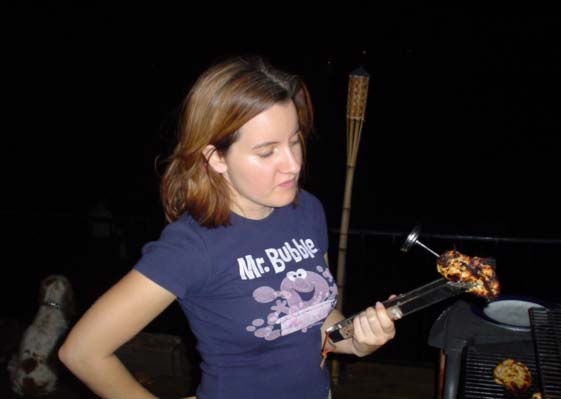Natalie Hoffman of the Napa Valley Register in California reported this a.m. that Little League baseball spectators in St. Helena will no longer be able to buy a hamburger during game time after three Napa Valley children got sick with E. coli O157:H7 from hamburger patties sold at a St. Helena Little League snack shack.
Jim Gamble, president of St. Helena Little League, said the organization’s snack shacks now serve only pre-packaged and pre-cooked food, although I suppose they could get pre-cooked patties if they really wanted them.
The patties were supplied by the Richwood Meat Company of Merced, Calif., which has been involved in a recall since the illnesses came to light a few weeks ago. Recently, a company official said consumers just needed to cook their hamburgers thoroughly. A Napa County Environmental Health echoed those statements in the story today, saying that the public can avoid E. coli contamination by cooking all beef — especially ground beef — thoroughly.
The complete story is available at:
http://www.napavalleyregister.com/articles/2007/05/06/news/local/iq_3936802.txt
But are consumers really the problem, or just part of the problem? My thoughts below.
dp

Produce, pet food and peanut butter — what’s a consumer to do?
06.may.07
Commentary from the Food Safety Network
foodsafety.ksu.edu
Produce, pet food and peanut butter.
Once home, there was nothing individual Americans could have done to prevent any of the illnesses and deaths associated with these products.
Yet there are a multitude of well-meaning groups who preach to the masses that food safety begins at home.
Since 1998, American consumers have been told by government- and industry-types to FightBac, that is to fight the dangerous bacteria, viruses and parasites by cooking, cleaning, chilling and separating their food. Solid advice, but limited.
For example, in 2004, Salmonella-contaminated Roma tomatoes used in pre-made sandwiches sold at Sheetz convenience stores throughout Pennsylvania sickened over 400 consumers. The FightBac folks told the public in a press release that, "In all cases, the first line of defense to reduce risk of contracting foodborne illness is to cook, clean, chill and separate."
Consumers were effectively being told that when they stop by a convenience store and grab a ready-made sandwich, they should take it apart, grab the tomato slice, wash it, and reassemble the sandwich.
Which would have done nothing to remove the Salmonella inside the tomatoes.
Are consumers really expected to cook all their fresh tomatoes and leafy greens untill 165F to kill salmonella? Fry up peanut buter? Bake the cat food (not that it would do any good)?
Food safety begins on the farm, and extends through processing, distribution, retail, food service and the home. And everyone has a responsibility to reduce the number of harmful bugs that may be present in food.
Yet last week, a California meat processor involved in another E. coli O157:H7 recall said the illness could be avoided if consumers just handled their beef correctly. He was blaming consumers, something most in the meat industry abandoned in the years following the 1993 Jack-in-the-Box outbreak. Even the U.S. Department of Agriculture dropped the blame game in 1994.
In mid-1994, Michael Taylor was appointed chief of USDA’s Food Safety and Inspection Service. On Sept. 29, 1994, USDA said it would now regard E. coli O157:H7 in raw ground beef as an “adulterant,” a substance that should not be present in the product. By mid-October, 1994, Taylor announced plans to launch a nationwide sampling of ground beef to assess how much E. coli O157:H7 was in the marketplace. The 5,000 samples would be taken during the year from supermarkets and meat processing plants “to set an example and stimulate companies to put in preventive measures.” Positive samples would prompt product recalls of the entire affected lot, effectively removing it from any possibility of sale.
That’s the long-winded version for what a USDA official said in a 1994 television interview: we’ll stop blaming consumers when they get sick from the food and water they consume.
Thirteen years later and the same message was stressed by Barbara Kowalcyk, who visited Kansas State University last month. Barbara’s life was profoundly shaken in 2001 following the death of her two-and-a-half year old son, Kevin, from complications due to an E. coli O157:H7 infection.
"What happened to my child was horrific," said Kowalcyk, "and afterwards, I was appalled at how little attention is focused on this very serious public health issue that affects millions of Americans each year."
After years of tireless volunteering and advocacy on behalf of the 76 million Americans sickened each year by the food and water they consume, Kowalcyk has formalized her activities by creating the Center for Foodborne Illness (http://www.foodborneillness.org).
In her talk and during our conversation afterwards, Kowalcyk emphasized that she always stressed safe food handling and found it particularly galling when groups directly — or indirectly — blamed consumers. Today, such accusations usually take the form of unsubstantiated statements such as, "The majority of foodborne illness happens in the home." This, coupled with the cook, clean, chill, separate messages targeted at consumers (available at your grocer’s meat and seafood counter), perpetuates the myth that consumers are the primary cause of foodborne illness.
But as produce, peanut butter and pet food demonstrate, such messages are incomplete. The World Health Organization recognized this back in 2001 and included a fifth key to safer food: use safe water and raw materials, or, source food from safe sources (http://www.who.int/foodsafety/consumer/5keys/en/index.html).
The first line of defense is the farm, not the consumer. Every mouthful of fresh produce, processed food or pet food is an act of faith. And every grower, packer, distributor, retailer and consumer needs to put aside the paternal proclamations and work instead on developing a culture that actually values and protects microbiologically safe food.
Douglas Powell is scientific director of the International Food Safety Network at Kansas State University.
dpowell@ksu.edu










 Charlie Weis hasn’t publicly blamed his Fighting Irish players for the breakdown in the Sugar Bowl against LSU. This quality, Weiss’ responsibility for his team’s performance would make him a pretty good restaurant manager.
Charlie Weis hasn’t publicly blamed his Fighting Irish players for the breakdown in the Sugar Bowl against LSU. This quality, Weiss’ responsibility for his team’s performance would make him a pretty good restaurant manager.  information, and a training regime that is supported by regulators, which focuses on food safety risk year, 12 per cent of staff associated with restaurant outbreaks in Minnesota tested positive for Salmonella, but only half reported feeling sick. Managers and food handlers need to know this factors could lead to reduced risk.
information, and a training regime that is supported by regulators, which focuses on food safety risk year, 12 per cent of staff associated with restaurant outbreaks in Minnesota tested positive for Salmonella, but only half reported feeling sick. Managers and food handlers need to know this factors could lead to reduced risk.





